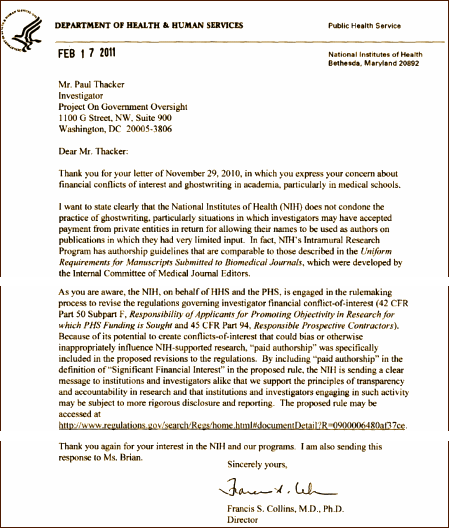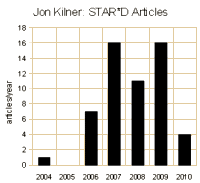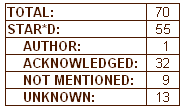When Doctor Francis Collins responded to POGO’s letter on ghost-writing in February, although I didn’t think he had gone far enough, I was impressed that he was at least taking the problem seriously.

As I’ve perused parts of the psychopharmacology literature, I’ve been aware that I read the acknowledgments before reading the articles themselves, looking for the tell-tale "editorial support" credit that now means "ghost-writer" to me. I didn’t read all the
STAR*D articles. I doubt that many have [including the authors]. PubMed has 123 articles with "star*d" in the title and there are plenty more than that. But as I ran across some of the lesser articles, I frequently saw "…acknowledge editorial support from Jon Kilner, M.S.,
M.A." Then I ran across one where Jon Kilner was actually the second author, so I decided to look him up. It wasn’t that hard – just a routine google search lead me to
http://kilnerwriter.net/. Entering the site, the right button took me to his science fiction novel
Songs of Ice and Darkness and the left button took me to his
Professional Medical & Scientific Writing/Editing Service. I went left. It’s what you’d expect – he does medical writing. Duh! But I didn’t go far enough. I mentioned him to someone else who suggested I click around some more. Like his
CV starts off with:
Provide professional medical and scientific writing and editing services to doctors and researchers. I currently serve clients in the Pittsburgh area, across the US, and in Singapore and Australia. I wrote the cover article for the March 2008 issue of Psychiatric Annals.
Singapore? That’s where John Rush went when he left Texas in 2008. That "cover article for the March 2008 issue of Psychiatric Annals" turned out to be the one where Jon Kilner was indeed listed as the second author – to John Rush:
Rush AJ, Kilner J, Fava M, Wisniewski SR, Warden D, Nierenberg AA, Trivedi MH. Clinically Relevant Findings from STAR*D. Psychiatric Annals. 2008; 38(3): 188-193.
Hmmm. Then I clicked on the link that said "To see a list of my published works,
click here." Go ahead, click it yourself. Under
Published Writing/Design Projects, there’s a manual and the cover article mentioned above. Under
Published Editing Projects, there’s a book chapter and about 70 journal articles –
54 of them are STAR*D articles! I’ll have to admit, that got my attention. So, since it’s my main pollen season and I’m mostly watching our beautiful spring through a double-glazed window, I did some tedious looking up this afternoon. There are my tabulated results in the upper right. Of Jon Kilner’s listed
STAR*D editing projects, there were 13 I couldn’t access. Of the remaining 42, he was

author in one [with John Rush], acknowledged for editorial support in 32, and unmentioned anywhere in 9. He was apparently not involved in the main report in the American Journal of Psychiatry.
Is he a STAR*D ghostwriter? Since he got his Masters Degree in Technical and Scientific Communication in 2003, 78% of his medical writing output has gone into STAR*D articles. I don’t know how to prove such a thing myself, but it sure looks suspicious to me. Maybe Francis Collins ought to look into it, since STAR*D is a NIH/NIMH funded study.
Since it doesn’t say how he’s paid, I suppose he’s being paid from the NIMH grant…


 author in one [with John Rush], acknowledged for editorial support in 32, and unmentioned anywhere in 9. He was apparently not involved in the main report in the American Journal of Psychiatry.
author in one [with John Rush], acknowledged for editorial support in 32, and unmentioned anywhere in 9. He was apparently not involved in the main report in the American Journal of Psychiatry.
See Dr. Rush’s ground rules for authorship here:
http://tinyurl.com/6ye7vcb
This information is really disheartening. Congratulations on exposing it, Mickey. My concern when a non-scientist professional writer takes the lead is that the finished article presents a predetermined set of conclusions or an incompetent analysis of the data. In most of my own publishing history, the end product bore only a passing resemblance to the original draft. Why? Because the process of writing a scientific paper consists in interrogating the data ever more rigorously. Whatever were these senior STAR*D academics thinking when they used Jon Kilner as the workhorse? What does he know about interrogating the data?
This information needs to get to the attention of NIH Director Francis Collins. We have to assume that NIMH Director Thomas Insel knows about this farce and is complaisant with it. Time for him to go.
Once again, great sleuthing! As I read through Jon Kilner’s listing of his ‘editorial assistance’/ghost-written 55 STAR*D articles, one thing that jumps out is how the listing of ‘authors’ is typically 9 to 13 ‘authors’ per article. The order of ‘authorship’ is always changing with the 9 to 13 named ‘authors’ for a given article being drawn from a pool of 20+ ‘authors.’
Certain ‘authors’ names are listed in virtually every article, typically in one of the most prominent positions (i.e., first, second, or last). While it is just my impression (I didn’t do a full analysis…but it is tempting), the ranking by frequency and prominence seems to be Rush, Trivedi, Fava, Wisniewski, Nierenberg, and Thase followed by lesser rotating ‘authors.’
An interesting anthropological paper would be an analysis of STAR*D ‘authorship’ by frequency and prominence in its 123 plus (and counting) STAR*D articles. For some reason, I have this image of the spoils of each new article’s ‘authorship’ being divvied up amongst those in the pool via one of Rush/Trivedi’s ‘evidence-based algorithms’ that is essentially unrelated to the substance of the article itself…with then each article actually being written by Jon or some other ghost! Don’t make waves, stay in the pool and see your publication count soar!
I also saw where Jon cites both of the step-2 New England Journal of Medicine articles in his list of published works. I did a quick check of these two most prestigious of the STAR*D articles, and Jon’s NIMH-funded ‘editorial assistance’ apparently went unacknowledged. Must have been an oversight on Rush, Trivedi, et al’s part.
Here are some relevant quotes from Jon’s website:
Under the “What I Can Do for You†page: “Interpret and translate your information to meet the needs of your readers†and “Craft your documents to enhance reader understandingâ€
Under the “Writing and Editing†page: “I can provide your organization with high quality documents containing clear text, effective data imagery, and professional document design in each of the following formats†with the first one listed being “JOURNAL ARTICLES.â€
This page concludes with “I will use my design skills to create a document with a clear, concise presentation that builds reader trust in you and your work.â€
Well, being a sufferer of ‘Chronic Intrigue Syndrome,’ I don’t trust anything Jon wrote for this 20 plus pool of STAR*D ‘authors.’ A bounty should be placed for discovering the likely other NIMH-funded STAR*D ghosts!
I’m with Dr. Carroll, “this information needs to get to the attention of NIH Director Francis Collins;†and it is time for Insel to go. How disgraceful to NIMH and all involved in this 35-million-dollar piece of science fiction. Have they no shame?
Begging your patience as I attempt to lay the general issue at the foot of my favorite villain, the Certified Public Accountant.
“Meme-chose”? In French it means “same thing”. In English: meme/mÄ“m/Noun
1. An element of a culture or behavior that may be passed from one individual to another by non-genetic means, esp. imitation
For at least several recent decades, the driving force behind the American landscape has been the ceaseless demand of Wall St. for the quarterly profit. The gamblers and traders themselves know little, and care even less – about making stuff, actually running companies, or even developing novel ideas (innovation). We’ve witnessed a tyrannical diminution in our collective capabilities and prospects as pennies are demanded on the price of a stock by the nation of clerks we’ve become.
Look at the recent history of American corporations being commanded by people who have come up through the “finance” organization (this is business-speak for a clerk who gets close to the flow of money and understands spreadsheets well enough to become a CFO and then gets to run the whole enchilada). This ‘type’ understands how to talk the language of the gamblers and may enjoy differential competitive advantage, (for a time), over peers who might possess productive knowledge.
All the while, important stuff is willfully neglected (R&D, infrastructure, peoples’ livelihoods, education….even “conservative” principles where corporate assets are concerned) – there are boat payments to be made, quarterly bonuses to distribute etc.
In academic medicine – if not academe in general – the “publish or perish” mantra has developed into its own industry driven again by incessant demand for results which more often than not have roots in cash money. Dr. Nemeroff had payments to make on his Rolls-Royce and I’m sure he stays in regular contact with his CPAs upon whom he trusts and relies for maintaining the bottom right hand corner of Charlie, Inc. spreadsheets. Dr. Insel has been running a big government agency and I’d hazard he has had to learn how to get along with the clerks in the GAO and perhaps he is good at it. Duke University competes for grants needed to fuel its apparent desire to spread its influence around the globe like other top-drawer academic institutions and pay outsized salaries to its executives along the way.
To paraphrase E.R. Murrow’s famous quote: “A nation of clerks begets mediocrity and wholesale decline.” (I’m also reminded of the symbol of the snake consuming itself from the back end.) Master Kilner and his colleague Sally may be paid shills but real accountability for what’s become of integrity in academic medicine or even American industrial competitiveness lies with the people who started out being doctors or gifted tinkerers and adopted the NYSE meme as their ‘raison d’être’. There is a place for the accountants – but it is not the place where they get to call all the shots and make all the decisions about what to do – about everything!
Is there ANY way to determine what psychiatric drug research we can believe? Really, this is incredible! It appears that the “research” that has been conducted and published in this area for about the last 25 years is rubbish! What gives?!?!